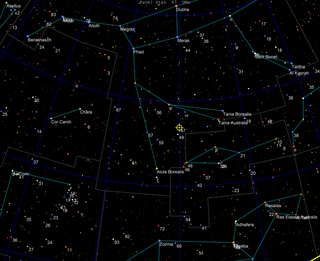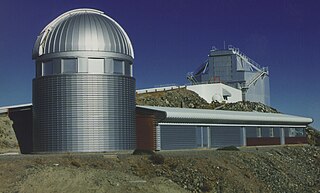Related Research Articles

47 Ursae Majoris, formally named Chalawan, is a yellow dwarf star approximately 46 light-years from Earth in the constellation of Ursa Major. As of 2011, three extrasolar planets are believed to orbit the star.
HD 74156 is a yellow dwarf star in the constellation of Hydra, 187 light years from the Solar System. It is known to be orbited by two giant planets.

HD 187123 is a single, yellow-hued star with two exoplanetary companions in the northern constellation of Cygnus. It has an apparent visual magnitude of 7.83, making it an 8th magnitude star that is too faint to be visible with the naked eye. However, it should be easy target with binoculars or small telescope. The system is located at a distance of 150 light years from the Sun based on parallax measurements, but is drifting closer with a radial velocity of −17 km/s.
HD 150706 is a 7th magnitude star in the constellation of Ursa Minor. It is a remarkably Sun-like yellow dwarf being only 6% less massive than the Sun.
ELODIE was an echelle spectrograph installed on the 1.93m reflector at the Observatoire de Haute-Provence in south-eastern France. Its optical instrumentation was developed by André Baranne from the Marseille Observatory. The purpose of the instrument was extrasolar planet detection by the radial velocity method.

47 Ursae Majoris c, formally named Taphao Kaew, is an extrasolar planet approximately 46 light-years from Earth in the constellation of Ursa Major. The planet was discovered located in a long-period around the star 47 Ursae Majoris. Its orbit lasts 6.55 years and the planet has a mass at least 0.540 times that of Jupiter.
HD 43691 is a G-type star with magnitude +8.03 located approximately 280 light-years away in the constellation Auriga. This yellow star is about to stop thermonuclear hydrogen-fusion in its core and eventually expand to become a red giant.
HD 89307 is a star in the equatorial constellation of Leo. It is too faint to be viewed with the naked eye except under ideal conditions, having an apparent visual magnitude of 7.02. The star is located at a distance of 105 light years from the Sun based on parallax, and is drifting further away with a radial velocity of +23 km/s.
HD 24040 is a metal-rich G-type star located approximately 152 light-years away in the constellation of Taurus. In 2006 a long-period planet was discovered.
HD 74156 c is an extrasolar planet with a minimum mass about eight times that of Jupiter orbiting the star HD 74156. It is most likely a gas giant. This planet was discovered by Dominique Naef and Michel Mayor in April 2001 together with the planet HD 74156 b. In 2022, the inclination and true mass of HD 74156 c were measured via astrometry.

HD 80606 b is an eccentric hot Jupiter 190 light-years from the Sun in the constellation of Ursa Major. HD 80606 b was discovered orbiting the star HD 80606 in April 2001 by a team led by Michel Mayor and Didier Queloz. With a mass 4 times that of Jupiter, it is a gas giant. Because the planet transits the host star its radius can be determined using the transit method and was found to be slightly smaller than Jupiter's. Its density is slightly less than Earth's. It has an extremely eccentric orbit like a comet, with its orbit taking it very close to its star and then back out very far away from it every 111 days.
HD 24040 b is a long-period exoplanet taking approximately 3500 days to orbit at 4.6 astronomical units in an almost circular orbit. It has a minimum mass 4 times that of Jupiter.

Leonhard Euler Telescope, or the Swiss EULER Telescope, is a national, fully automatic 1.2-metre (47 in) reflecting telescope, built and operated by the Geneva Observatory. It is located at an altitude of 2,375 m (7,792 ft) at ESO's La Silla Observatory site in the Chilean Norte Chico region, about 460 kilometers north of Santiago de Chile. The telescope, which saw its first light on 12 April 1998, is named after Swiss mathematician Leonhard Paul Euler.
HD 28254 is an 8th magnitude G-type main sequence star located 180 light years away in the constellation Dorado. This star is larger, cooler, brighter, and more massive than the Sun, and its metal content is 2.3 times as much as the Sun. In 2009, a gas giant planet was found in orbit around the star.
HD 28254 b is an extrasolar planet which orbits the G-type main sequence star HD 28254, located approximately 178 light years away in the constellation Dorado.
HD 156411 is a 7th magnitude G-type main-sequence star located approximately 186 light years away in the southern constellation Ara. This star is larger, hotter, brighter, and more massive than the Sun. Its metal content is three-fourths as much as the Sun. The star is around 4.3 billion years old and is spinning with a projected rotational velocity of 1.8 km/s. Naef and associates (2010) noted the star appears to be slightly evolved, and thus may be in the process of leaving the main sequence. In 2009, a gas giant planet was found in orbit around the star.
HD 25171 is a star in the southern constellation of Reticulum, the reticle. With an apparent visual magnitude of 7.79, this star is too faint to be viewed with the naked eye. However, it is readily visible through a small telescope from the southern hemisphere. Parallax measurements made during the Hipparcos mission place it at a distance of roughly 179 light-years from Earth. It has a planetary companion that was announced December 2009.
HD 113538 is a star with two planetary companions in the southern constellation of Centaurus. It is much too faint to be viewed with the naked eye at an apparent visual magnitude of 9.05. The distance to this star is 53 light years and it is drifting further away with a radial velocity of +39 km/s.
HD 222155 is a star in the northern constellation of Andromeda. It is a yellow star that can be viewed with binoculars or a small telescope, but is too faint to be seen with the naked eye at an apparent visual magnitude of 7.1. The imaging survey in 2017 did not detect any stellar companions to HD 222155.
HD 1690 is a 9th magnitude orange giant star located approximately 2,500 light-years away in the constellation of Cetus. It is a single star, and is the host star to one known extrasolar planet.
References
- 1 2 Naef, Dominique; Mayor, Michel; Beuzit, Jean-Luc; Perrier, Christian; Queloz, Didier; Sivan, Jean-Pierre; Udry, Stéphane (2004). "The ELODIE survey for northern extra-solar planets. III. Three planetary candidates detected with ELODIE" (PDF). Astronomy and Astrophysics . 414 (1): 351–359. arXiv: astro-ph/0310261 . Bibcode:2004A&A...414..351N. doi:10.1051/0004-6361:20034091. S2CID 16603563.
- 1 2 "Exoplanets: The Hunt Continues!" (Press release). Garching, Germany: European Southern Observatory. April 4, 2001. Retrieved December 27, 2012.
- 1 2 3 4 5 Feng, Y. Katherina; et al. (2015). "The California Planet Survey IV: A Planet Orbiting the Giant Star HD 145934 and Updates to Seven Systems with Long-period Planets". The Astrophysical Journal. 800 (1). 22. arXiv: 1501.00633 . Bibcode:2015ApJ...800...22F. doi:10.1088/0004-637X/800/1/22. S2CID 56390823.